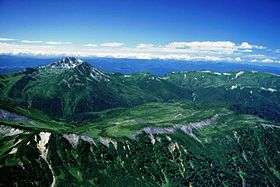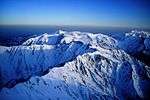Mount Kurobegorō
| Mount Kurobegorō | |
|---|---|
| 黒部五郎岳 | |
 Mount Kurobegorō and Kumonotaira seen from Mount Suishō | |
| Highest point | |
| Elevation | 2,897.48 m (9,506.2 ft) [1] |
| Listing |
List of mountains in Japan 100 Famous Japanese Mountains |
| Coordinates | 36°23′33″N 137°32′24″E / 36.39250°N 137.54000°ECoordinates: 36°23′33″N 137°32′24″E / 36.39250°N 137.54000°E [2] |
| Naming | |
| Pronunciation | [ku͍ɽobeɡoroːdake] |
| Geography | |
| Parent range | Hida Mountains |
| Topo map |
Geospatial Information Authority 25000:1 三俣蓮華岳[2] 50000:1 槍ヶ岳 |
| Climbing | |
| Easiest route | Hike |
Mount Kurobegorō (黒部五郎岳 Kurobegorō-dake) is one of the 100 Famous Japanese Mountains,[3] reaching the height of 2,839.58 m (9,316 ft). It is situated in Japan's Hida Mountains in Gifu Prefecture and Toyama Prefecture. It was specified for Chūbu-Sangaku National Park on December 4, 1934.[4]
Outline
The origin of the mountain name is the meaning that the stone rolls. It is said "gōro" in Japanese. Also this mountain is located in the source part of the Kurobe River. Then it is called "Kurobe-Gorō".[3] In the hillside on the east side, there is big Cirque geographical features that is the hollow where the shovel was scooped out. The upper part of this mountain is situated in Tree line region, Siberian Dwarf Pine and Alpine plant grow naturally. There are quite a lot of kinds of alpine plant in the surrounding, and it is selected to "the 100 famous Japanese mountains of flower" by Sumie Tanaka.[5]
Mountaineering
In December 1931, Buntarō Katō of Japanese mountain climbers had climbed it alone.
Main ascent routes
There are several climbing routes to the top of the mountain.[6][7]
- Hietsu-shin-dō
- Kamioka-shin-dō
- Arimine-guchi
- The west Ginza diamond course (from Oritate – Mount Kurobegorō – to Mount Yari)
There are the Ridge Line and Cirque routes from the Kurobegorō hut to the top.
Mountain hut
Thera are several mountain huts around Mount Kurobegorō.[7]
- Kurobegorō hut (黒部五郎小舎 Kurobegorō-goya) – in the col between Mount Kurobegorō and Mount Mitsumatarenge (with Campsite)
- Tarōdaira hut (太郎平小屋 Tarōdaira-goya) – in the col between Mount Yakushi and Mount Tarō (with Campsite)
- Mitsumata mountain cottage (三俣山荘 Mitsumata-sansō) – in the col between Mount Mitsumatagenge and Mount Washiba (with Campsite)
Alpine plant
A lot of Alpine plant are seen in the surrounding.
| Lilium medeoloides | Veratrum stamineum | Trollius japonicus | Geum pentapetalum | Geranium yesoemse |
|---|---|---|---|---|
 |
 |
 |
 |
Geography
Nearby mountains

| Image | Mountain | Elevation | Distance from the Top |
Note |
|---|---|---|---|---|
| Mt. Yakushi 薬師岳 |
2,926.01 m (9,600 ft) | 8.5 km (5.3 mi) | 100 Famous Japanese Mountains | |
 |
Mt. Kitanamata 北ノ俣岳 |
2,662 m (8,734 ft) | 4.0 km (2.5 mi) | |
 |
Mt. Kurobegorō 黒部五郎岳 |
2,839.58 m (9,316 ft) | 0 km (0.0 mi) | 100 Famous Japanese Mountains |
 |
Mt. Mitsumatarenge 三俣蓮華岳 |
2,841.23 m (9,322 ft) | 4.3 km (2.7 mi) | 300 Famous Japanese Mountains Boundary of three prefectures Toyama, Gifu and Nagano |
 |
Mt. Kasa 笠ヶ岳 |
2,897.48 m (9,506 ft) | 0 km (0.0 mi) | 100 Famous Japanese Mountains |
 |
Mt. Yari 槍ヶ岳 |
3,180 m (10,433 ft) | 11.2 km (7.0 mi) | 100 Famous Japanese Mountains |
Rivers
The mountain is the source of the following rivers, each of which flows to the Sea of Japan.[7]
- Nakanomata River (tributary of the Takahara River)
- Kanekido River (tributary of the Jōganji River)
- Uma River and Gorō River (tributaries of the Kurobe River)
Scenery of Mount Kurobegorō
| from Mt. Kasa | from Mt. Washiba | from Mt. Yari | from Mt. Yari (sunset) |
|---|---|---|---|
 |
 |
 |
 |
References
- ↑ "Information inspection service of the Triangulation station" (in Japanese). Geospatial Information Authority of Japan,(高山-槍ヶ岳-三俣蓮華岳). Retrieved December 29, 2010.
- 1 2 "Map inspection service" (in Japanese). Geospatial Information Authority of Japan,(高山-槍ヶ岳-三俣蓮華岳). Retrieved December 29, 2010.
- 1 2 "100 Famous Japanese Mountains". Kyūya Fukada (in Japanese). The Asahi Shimbun Company,ISBN 4-02-260871-4,pp198-198. 1982.
- ↑ "Chūbu-Sangaku National Park". Ministry of the Environment (Japan). Retrieved December 29, 2010.
- ↑ "100 Famous Japanese Mountains of flower". Sumie Tanaka (in Japanese). Bungeishunjū,ISBN ISBN 4-16-352790-7,pp221-224. 1995.
- ↑ "Alpen guide: Kamikōchi, Mount Yari and Mount Hotaka" (in Japanese). YAMA-KEI Publishers, ISBN 4-635-01319-7). 2000.
- 1 2 3 "Mountain and plateau map of Mount Tsurugi and Mount Tate" (in Japanese). Shobunsha Publications,ISBN 978-4-398-75716-6. 2010.
See also
| Wikimedia Commons has media related to Mount Kurobegorō. |
